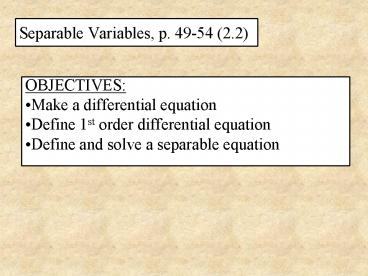Separable Variables, p' 4954 2'2
1 / 17
Title:
Separable Variables, p' 4954 2'2
Description:
per unit of time ... By inspection N(t)=ekt is the solution of ... one-parameter family of solutions a solution containing an arbitrary constant, p. 7. ... –
Number of Views:51
Avg rating:3.0/5.0
Title: Separable Variables, p' 4954 2'2
1
Separable Variables, p. 49-54 (2.2)
- OBJECTIVES
- Make a differential equation
- Define 1st order differential equation
- Define and solve a separable equation
2
Assumptions, p. 20
- The number of organisms in a population depends
on births and deaths. - N the number of organisms at time t , or
- N(t) the number of organisms at time t.
- b birth rate (constant)
- bN number of births
change in population per unit of time
births
deaths
d death rate (constant) dN number of deaths
3
Mathematical formulation, p. 20
- bN dN or
- Let
- differential
- equation
change in population per unit of time
4
- differential equation (DE) equation with
derivatives of one or more dependent variables,
with respect to one or more independent
variables, p. 2. - ordinary differential equation (ODE) equation
with only ordinary derivatives with respect to a
single variable, p. 2. - is an ODE.
- Partial differential equation (PDE) equation
with partial derivatives of two or more dependent
variables with respect to two or more independent
variables, p. 2. - is a PDE.
5
- order of DE order of highest derivative in DE,
p. 3. - is a 1st order ODE.
- is a 1st order ODE
- May be written as
- or
- is a 2nd order PDE
6
- Note this means that the rate of growth is
proportional to the population size - , p. 20.
- What function is equal to its own derivative?
7
- Consider N (t) ekt.
- By inspection N(t)ekt is the solution of
- Definition 1.2, p. 5
- solution any function defined on some interval
I , which when substituted into a differential
equation reduces the equation to an identity. - Is this the only solution?
- N (t) 0 is called the trivial solution, p. 5.
8
Obtain solutions, p. 20
- Solve the differential equation
- ln N(t) 3t C , C constant
- N(t) e 3t C
- is a separable equation.
eCe3t
Ae3t, A eC
9
Definition 2.1, p. 50 separable a first order
differential equation of the form
- Method of solution, p. 50
- To solve
- Multiply by dx and to obtain
- Integrate both sides
- A solution is H(y) G(x) c, where H, G are
antiderivatives.
10
- N(t) Ae 3t is an explicit solution of the
differential equation - explicit solution a solution in which the
dependent variable is expressed solely in terms
of the independent variable and constants, p. 6. - How many solutions does N(t) Ae 3t represent?
11
- integral solution of a differential equation,
p. 7. - What is the graph of the integral N (t) Ae3t ?
- (Refer to Calculus Text, p. 50)
- integral curve or solution curve graph of a
solution, p. 7.
A 2
N (t)
A 1
A 1/2
t
12
- one-parameter family of solutions a solution
containing an arbitrary constant, p. 7. - N (t) 2e3t
- N (t) e3t
- N (t) 1/2e3t
- particular solution a solution of DE that is
free from arbitrary parameters, p. 7.
A 2
N (t)
A 1
A 1/2
t
13
Consider solution N (t) Ae3t subject to N(0)
50.
Ae 3(0)
A
50 N(0)
N (t) 50e3t
initial-value problem (IVP) - on some interval I
containing x0, Solve Subject towhere
y0 is an arbitrarily specified real constant, p.13
14
- Does a solution EXIST?
- Is the solution UNIQUE?
- Let f (t, N) 3N(t), then
- Observe that f (t, N) and are continuous on all
of the real number line. - Therefore solution for the IVP
- N(0) 50.
N (t)
(0, 50)
t
I
15
- Theorem 1.1 R is a region in xy-plane defined
by , containing the point (x0, y0) in its
interior, p. 50. - If f (x, y) and are continuous on R.
- Then an interval I centered at x0 and a unique
function y(x) defined on I satisfying the IVP.
y (x)
(x0, y0)
d
c
x
b
a
I
16
Steps of the modeling process, p. 20
Express in terms of DEs
Mathematical formulation
Assumptions
Solve DEs
Make alterations
Check model predictions with known facts
Obtain solutions
Graph predictions
17
Homework
- p. 10 11-14
- p. 16 1-6
- p. 25-27 1-4
- p. 35-37 1-40 alternate odd
- Read p. 57-65 (2.3)
- Office hours M-FRI 900 1015































